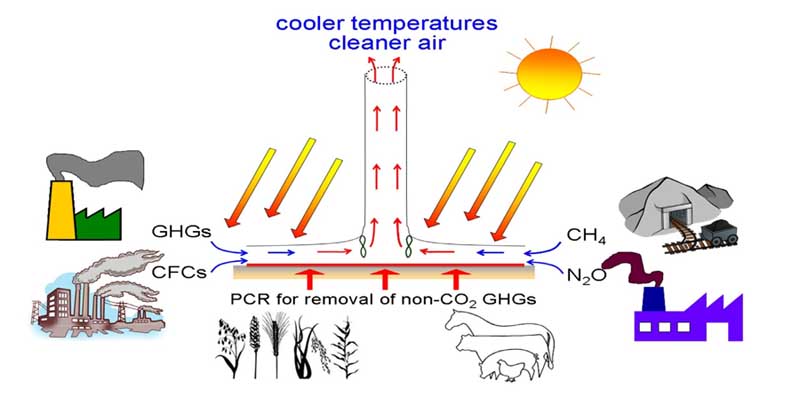The Comings Foundation
Carbon Capture, Methane Capture, CO2 Removal and
Counteracting Ocean Acidity
So what do we make of all the information reviewed in the Comings Foundation web site? While we would like to support most of the companies and foundations listed in the Summary of Proposed Support page, to be maximally effective we need to prioritize some of them.
It is now the consensus of the International Panel on Climate Change (IPCC), the European Academies of Science Advisory Council (EASAC), the National Academy of Sciences (NAS) and other sources (1-5) that in addition to decreasing CO2 emissions, the direct removal of atmospheric CO2 and CH4 (methane) will also be necessary. This approach is called NET or Negative Emissions Technology.
The size of the problem is immense with the U.S producing total emissions of ~6.5 Gt CO2 annually and more than 50 Gt CO2 being produced globally. Given this magnitude it is clear that BOTH the reduction of emissions and NET will be necessary. A 2018 NSF study (1) concluded that If the goals for climate change and economic growth are to be achieved, negative emissions technologies will need to play a large role in mitigating climate change by removing ~10 GtCO2/y globally by midcentury and ~20 Gt CO2 /y globally by the century’s end. The remarkable benefit derived from phasing out coal for the generation of electricity is illustrated by the fact that a 500-MW coal-fired power plant emits on average 11,000 tons of CO2 per day!
It is clear there is a need to focus on CH4 as well as CO2 . Other Greenhouse Gases (GHGs), besides CO2 , together account for about 34% of radiative forcing. Even if all excess anthropogenic atmospheric CO2 were removed, radiative forcing would only be reduced by about half.
In summary, the major goals of the Comings Foundation are:
1. Remove CO2 from the atmosphere.
2. Remove methane from the atmosphere
3. Reduce methane emissions from cattle
4. Determine what to do with the CO2
5. Decrease ocean acidity.
Carbon 180 has listed 252 companies (Circular Carbon Network) that are fighting climate change in a variety of ways. These companies were divided as follows:
Algae and phytoplankton 27 companies
Biochar 6 companies
Methods of Carbon Capture 27 companies
CCM (Minealization) 16 companies
CCU (Utilization) 58 companies
Cement 5 companies
CO2 to Fuel 38 companies
Energy Production 14 companies
We have selected some of these 252 companies that had technologies that were especially notable plus adding one of our own i.e. DCC + SCPP + PCR.
For example, two of the major problems of CC and sequestration is the expense for the energy required for the technology and what to do with the CO2 . The following two companies have solved both of these issues as well as the issue of the amount of land needed and decreasing ocean acidification.
The oceans cover 71 percent of the earth's surface and the CO2 content in the ocean is 50 times that in the atmosphere and 20 times that in the soil (12). Approximately 30 percent of C02 produced by burning fossil fuels is adsorbed by the oceans (13). The critical role of phytoplankton in the CO2 cycle was discussed in the Global Warming is Real, section of this web site.
Two companies, SeaQuestration and Ocean Based Climate Solutions use different technologies to enhance the growth of phytoplankton and other organisms to increase the capture of CO2. Since the captured CO2 is in the ocean this decreases atmospheric CO2, decreases ocean acidification and eventually decreases ocean and atmospheric warming. Since the oceans are so vast these approaches have the potential to remove huge quantities of CO2 from the atmosphere. Two phytoplanktons, diatoms and coccolithophorids play a major role because after they adsorb C02 they sink to the bottom of the ocean, effectively removing the C02. Thus, one additional option would be to grow large amounts of these phytoplanktons and dump them in selected parts of the ocean (14).
SeaQuestration.
This technology uses common materials and preexisting resources to create significant biomass in existing ocean ‘deserts’. This both saves and utilizes endangered pelagic fish species (e.g. tuna), and removes CO2 from the atmosphere in significant quantities. Using natural processes, it reverses ocean acidification and sequesters CO2, preventing further heating of the atmosphere. This technology is scalable to remove both the excess CO2 in the atmosphere, and all the current fossil fuel CO2.
Ocean Based Climate Solutions
At no direct cost, corporations can remove a gigaton of CO2 by sponsoring our Oxygenators. Each unit deployed in the open ocean uses wave energy to bring up nutrients, triggering photosynthesis, growing phytoplankton that absorb CO2 and give off oxygen. This is 100% natural and provides half the oxygen we breathe, while sequestering one-third of mankind’s annual CO2 emissions. By paying the cost in common stock rather than cash, market cap recovers as investors prefer more sustainable solutions.
Importantly, these technologies address the potential tipping point of ocean warming killing phytoplankton. Phytoplankton account for half of all CO2 seqestration, (see Loss of Ocean Phytoplankton in the Global Warming is Real page).
Another company that has solved the problem of the energy required is Blancair. They produce wind turbines that extract CO2 from the air.
Blancair
We can generate electricity, gather CO2 at the same time and use the recovered raw material to produce synthetic gasses or fuels directly at the turbine or in the wind farm. There is no downtime of the wind farm when the grid is overloaded, since the wind energy by the combined use of the CO2 can be stored as e-Fuels with the well-known power-to-liquids technology. The system works in a passive mode – no energy is consumed for collecting CO2.
None of the 252 companies addressed removal of methane. The following approach does.
DCC + SCPP + PCR
DCC refers to Direct Carbon Capture.
SCPP refers to Solar Chimney Power Plant.
PCR refers to Photo Catalytic Reactor.
The concept is illustrated in the Negative Emission Technology section of the ComingsFoundation website under J Methane.
The SCPP is an established concept that generates electricity in a solar updraft tower incorporating axial-flow turbines. Hot air is supplied to the tower by a large solar hot air collector. A conventional SCPP is composed of 4 principal components: (6,7)
1. A very large collector for the greenhouse effect;
2. A tall chimney for the stack effect;
3. A thermal energy storage layer (water) to store the solar radiation for night-time operation;
4. Several turbines to generate renewable electricity which is carbon free.
SCPP has the potential to produce inexpensive electricity. It would be especially suitable for countries with sun but few resources.
PCR (Photocatalytic Reactor) can be incorporated in the SCPP by coating its collector with a photo catalyst (6), such as TiO2, which is able to transform methane and other non-CO2 GHGs into less harmful products. For example, the transformation of 1 kg of methane into 2.75 kg of CO2 reduces its climate change effect by 90% and is equivalent to the removal of 25.25 kg of CO2 from the atmosphere.
Reducing CH4 from Cattle As mentioned in the web page section on methane under Negative Emissions Technology, compounds in red kelp (algae) when put in cattle feed dramatically reduce their production of methane in burps and farts. We propose to provide funding to make this available to cattle ranchers at minimal or no cost.
An additional method is provided by Zelp (see section on methane). This London company has developed a mask for cattle the removes 90% of the methane emissions of cattle and provides a number of other benefits to managing cattle.
XXXXXXXXXXXXXXXXXXXX 
We propose to bring this technology to the U.S. and other countries.
Other Approaches These will not be the sole goals of The Comings Foundation. As outlined in the www.thecomingsfoundation.org website, other approaches to combating climate change including support of the development of perennial or suberin containing crops, ocean farming, and others will also be supported.
References
1. National Academies of Sciences, Engineering, and Medicine 2018. Negative Emissions Technologies and Reliable Sequestration: A Research Agenda. Washington, DC: The National Academies Press. 369 pp. https://doi.org/10.17226/25259.
2. National Research Council 2015. Climate Intervention: Carbon Dioxide Removal and Reliable Sequestration. Washington, DC: The National Academies Press 155 pp .https://doi.org/10.17226/18805.
3. Ernest J. Moniz, E.J. and Yergin, D.: Advancing the Landscape of Clean Energy Innovation. Breakthrough Energy 229 pages, Feb 2019.
4. Negative Emissions Review. Part 1: Research landscape and synthesis Minx et.al. Environ. Res. Lett. 13: 1-29, (2018) Part 2: Costs, potentials and side effects Fuss et.al. Environ. Res. Lett. 13: 1-47, (2018) Part 3: Innovation and upscaling Nemet, et. al. Environ. Res. Lett. 13: 1-30, (2018)
5. Popkin, G: The Forest Question. Nature 563:200-282, 2019
6. deRichter, R. et al.:Removal of non-CO2 greenhouse gases by large-scale atmospheric solar photocatalysis. Progress in Energy and Combustion Science 60:68-96, 2017.
7. Schlaich,J.et. at.: Design of commercial solar updraft tower systems-Utilization of solar induced convective flows for power generation. J Sol Engineering 127:117–24, 2005.
8. Lewis, S.L. and Wheeler, C.E. Regenerate natural forests to store carbon. Nature 568:25-28, 2019.
9. M. T. Styles, et al. The variation in composition of ultramafic rocks and the effect on their suitability for carbon dioxide sequestration by mineralization following acid leaching. Published online at Wiley Online Library (wileyonlinelibrary.com). DOI: 10.1002/ghg.1405, 2013.
10. Jia, et al: Ab Initio Molecular Dynamics Study of Carbonation and Hydrolysis Reactions on Cleaved Quartz (001) Surface J. Phys. Chem.123: 4938-4948, 2019
11. CO2 Sciences: Global Roadmap for Implementing CO2 Utilization. Nov 2016.
(12) Homen, K. The Global Carbon Cycle International Geophysics 72:282-321, 2000.
(13) La Quere, C et al Global Carbon Budget. Earth System Science Data 6:235-263, 2013.
(14) MicroBio Engineering, Inc. a California based company with expertise in growing phytoplankton could help.

